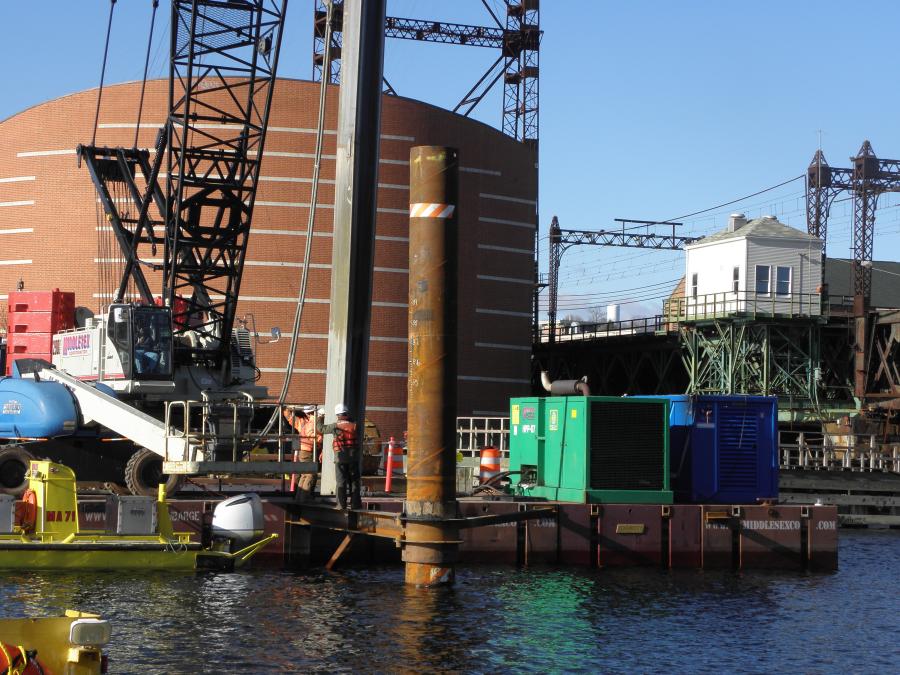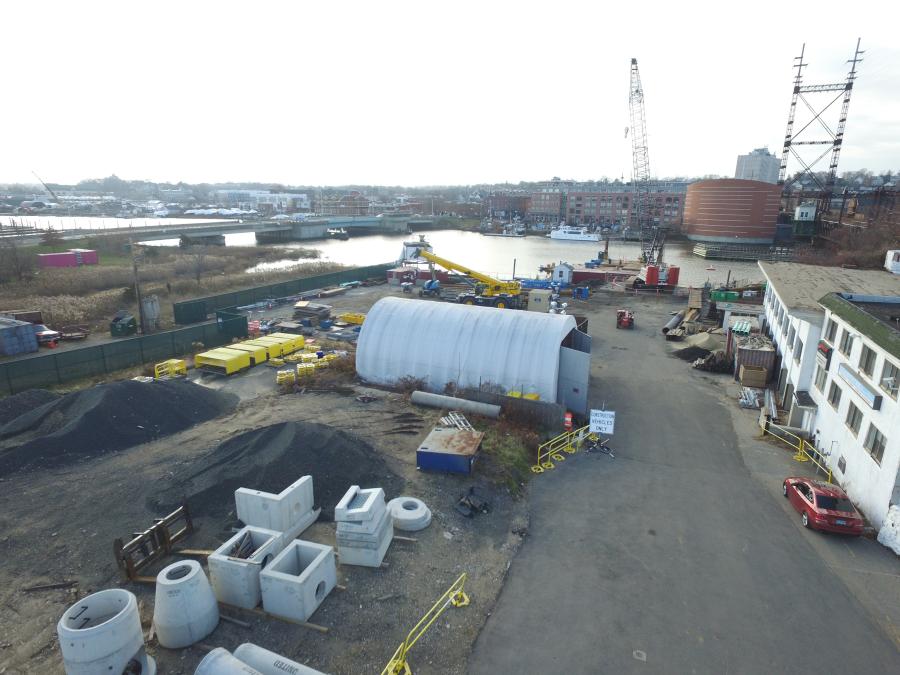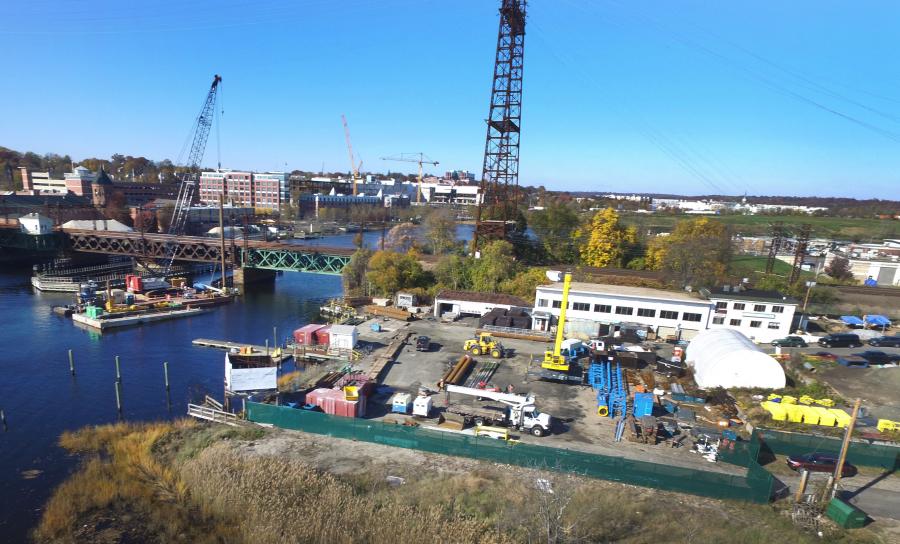Pre-construction work is under way on The Walk Bridge Replacement Project.
In Connecticut, pre-construction efforts are under way on The Walk Bridge Replacement Project. The project is currently at 60 percent design, and is expected to start construction by summer of next year.
"Preliminary work is being conducted to determine the location of underground utilities and drainage," said Connecticut Department of Transportation (CTDOT) project manager James A. Fallon. "The Test Pile Program (TPP) was conducted in late 2018 to collect noise and vibration data."
The TPP was a sequence of pile-driving activities to gather information that helps the program identify potential effects of noise and vibration to the area neighboring the Walk Bridge. Specifically, 30-in. diameter steel pipe piles and PZ 35 steel sheet pile pairs were driven in the river at various locations for proposed Walk Bridge construction.
Fallon said replacing the 123-year-old deteriorated bridge with a resilient bridge structure enhances the safety and reliability of rail service, while also providing operational flexibility and ease of maintenance.
"The replacement increases rail transportation capacities and efficiencies along the Northeast Corridor (NEC), while maintaining and improving navigational capacity and dependability of the Norwalk River. Replacement of the Walk Bridge is necessary to improve bridge reliability, incorporate bridge redundancy and provide a sustainable structure for significant weather events. Replacement is essential to accommodate current and future rail service and marine traffic."

A crane and other equipment were set up last fall to complete the TPP that included a series of pile-driving activities in advance of the Walk Bridge Replacement Project. (CTDOT Photo)
By 2011, a pattern of bridge closure incidents raised concerns. During this time, the Walk Bridge failed to close 12 out of 138 openings, and failed 16 times in 2013. In 2014, the bridge failed twice within a two-week period. These events caused significant service delays and required emergency busing of rail passengers. The Commissioner of CTDOT signed an emergency declaration letter, accelerating the Walk Bridge Replacement Project.
The project is expected to reach 90 percent design this summer.
While the total cost of the Walk Bridge Program is $1.2 billion, the current Walk Bridge Replacement Project construction estimate is $511 million. The construction cost of the other elements of the program, including the CP243 Interlocking and Danbury Branch Dockyard projects, is approximately $424 million.
"The overall Program offers many benefits to the community that we want people to understand," said Fallon. "The Walk Bridge Program enhances safety, reliability and ease of travel to, from and through Norwalk, Conn., and along the MNR NHL and the overall Northeast Corridor. The Program's interrelated road, rail and utility projects preserve and improve upon key assets, like the railroad infrastructure and the Norwalk River.
"Projects are conducted simultaneously to take advantage of scheduled track outages and to streamline work. This approach reduces rail disruptions, lowers costs and shortens construction durations that would be necessary to complete the infrastructure improvements individually. The Program promotes economic development through infrastructure investment, the protection of current and potential up-river development, increased railroad reliability and reduced road congestion for residents, commuters, businesses and tourists."

Replacing the 123-year-old deteriorated bridge with a resilient bridge structure enhances the safety and reliability of rail service, while also providing operational flexibility and ease of maintenance.
Fallon noted that when working near an active railroad, a navigable waterway and a busy urban center, construction staging and logistics can be challenging.
"The Program is committed to maintaining both rail service and marine traffic throughout construction. There are adjacent properties and buildings as close as nine feet to the railroad bridge. Coordination between many stakeholders, including the city of Norwalk, Metro-North Railroad, the United States Coast Guard, the Norwalk Harbor Management and Shellfish Commissions, Marine Police, local neighborhood groups and associations, the business community, local transit organizations, historical groups, rowing clubs, residents, commuters, etc., requires open communication and active engagement. Working with the community is one of the elements that makes the project so rewarding."
A crane and other equipment were set up last fall to complete the TPP that included a series of pile-driving activities in advance of the Walk Bridge Replacement Project. The piles were driven with diesel and hydraulic driving hammers and hydraulic vibrator hammers from a crane-mounted barge. Land-based H-piles were driven near the Fort Point Street and East Avenue rail bridges. There was close coordination with nearby stakeholders, including the Maritime Aquarium. All activities were monitored with noise and vibration equipment.
Data collected through this activity assists in identifying potential effects of noise and vibration to the area neighboring the Walk Bridge. It helps form a noise and vibration plan to mitigate construction impacts during replacement of the bridge. The removal of old wood piles at the former marina site was included for water safety reasons.
Aside from preliminary activities, the bulk of the work has not begun.
"The completion of the TPP can be considered an early milestone, but construction on the Walk Bridge Project is not anticipated to begin until summer 2020," said Fallon. "Additional subsurface investigations, including test pits, are needed in advance of construction on the Walk Bridge. At this time, this work is unscheduled. An advanced utility relocation project is being designed, and is anticipated to be in construction in 2020."
The first year will consist mostly of in-water work and establishing the staging areas.
"This includes demolition of the IMAX theater, and relocation of the railroad power lines underground. In year two, we remove the existing high towers and construct the lift towers for the new Walk Bridge. We will start the construction of the southerly two tracks. While the southern tracks are out of service, work will begin on the concurrent Fort Point Street, East Avenue and Osborne Avenue railroad bridge replacement projects. During the third year of construction, we will complete the Walk Bridge's southern half approaches.

The first year will consist mostly of in-water work and establishing the staging areas.
"The southern lift span will be built off-site using approximately three million pounds of steel and 45,000 bolts. The span will be floated-in and installed over an extended weekend while the existing swing span [all four tracks] is simultaneously removed and floated north for demolition. The Program would then open the two new southern tracks and begin work on the northern half of the bridge. This work will mirror the southern half and extends into year 4/5. The completion of the northern and southern halves of the bridges at Fort Point Street, East Avenue, and Osborne Avenue will occur simultaneously, to coincide with track outages for the Walk Bridge."
According to Fallon, the program excavation work will include excavation of roadways, abutments, retaining walls, temporary SOE (i.e. soil nail walls), catenary foundations, drilled shafts, micro-piles, sub-ballast removal, utility relocation and platform foundations. The excavation will take place in various locations throughout the program, such as East Avenue, Fort Point Street, Osborne Avenue and The Walk Bridge.
Over the course of the contract, the Walk Bridge and all three smaller bridges will require an extensive amount of dirt/material to be moved.
In addition, various cranes will assist the construction of new structural components, as well as the demolition of existing structural elements.
Each of the four trestle structures are anticipated to have a full-time crawler crane with up to 280 ft. of boom for drilled shaft casings, structural steel erection, and general construction support. It's expected that 350-ton and 650-ton crawler cranes with a variable-radius counterweight system will be used for demolition and erection of approach span superstructure elements, as well as demolition of the "High Tower" transmission line structures.
A 200-ton crawler crane with clamshell bucket will likely be used for drilled shaft excavation, along with a 230-ton crane with 280 ft. of boom mounted on a ring to a 200-ft. long barge for lift span sheaves and other major picks.
Rolling gantries, micro-piles and slide-in systems will be required for low-clearance drilled shaft installation below the existing bridge, as well as at other limited clearance areas. Several sizes and configurations of excavators will be utilized, including long-reach and limited-tailswings, to assist with various operations, including earth excavation. Loaders will be needed for the extensive earth excavation effort.
Pile-driving equipment will drive pipe piles for trestles and sheet pile marine enclosures. Pile driving is limited during certain times of the day and uses "soft starts" to limit environmental, noise and vibration impacts. Dump trucks will transport materials on land to a central stockpile area for sorting and processing.
In addition, track equipment, such as Hi-Rail Grapple trucks, will be used to access and remove/install railroad components during train service outages. Other "non-rail" equipment will be track-mounted to be able to access the site and perform operations near the tracks.
Multiple sizes of aerial lift equipment will be on site for the duration of the project, including telescoping and limited-tailswing man-lifts.

The project is currently at 60 percent design, and is expected to start construction by summer of next year. (CTDOT Photo)
Several types of barges may be used to transport materials and equipment — ocean-going barges up to 250 ft. long, flat-deck cargo barges up to 120 ft. long, scow barges for drilled shaft cutting water circulation and barges equipped with various excavators, cranes and dredging equipment. A fleet of support vessels, including push boats, safety boats and crew boats, will be available to support marine operations.
Time-of-day constraints, tidal constraints, turbidity curtains and other protective measures will be used to limit disturbance of the sensitive marine environment. Marine construction activities are limited to work on one side of the river at a time, to allow safe passage for fish and marine life.
The main materials used during construction will be steel for the superstructures, concrete for the substructure, HMA for the roadways, ties for the track, ballast and sub ballast for the railway and various cable for OCS. These materials are designed to have a life expectancy of more than 75 years.
As for the most time-consuming part of the work, said Fallon, "It will be the construction and erection of the lift spans of the Walk Bridge. The assembly of these two lifts spans are expected to take approximately nine months each."
Construction of the Walk Bridge is estimated to take four to five years.
Cindy Riley
Birmingham, Ala., native Cindy RIley originally planned on a career in law, but during her sophomore year in college realized journalism was her true calling. A magna cum laude graduate of Samford University, Riley first worked in radio and TV. Named Best News Anchor, Best News Reporter and Best Investigative Reporter by the Associated Press, she interviewed numerous personalities, ranging from Dr. Henry Kissinger and President Bush to Michael Jordan and Captain Kangaroo.
As a print journalist, Riley has covered a variety of topics, including construction, business, health and the arts. In addition to CEG, her work has appeared in special reports for USA Today and the L.A. Times. Other publications have included New South Magazine, Portico, Thicket, Alabama Heritage, B-Metro, Business First and Birmingham Business Journal.
Read more from Cindy Riley here.
Today's top stories




















